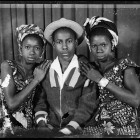About
Seydou Keïta’s (1921 - 2001) photographs eloquently portray Bamako society during its era of transition from a cosmopolitan French colony to an independent capital. Initially trained by his father to be a carpenter, Keïta’s career as a photographer was launched in 1935 by an uncle who gave him his first camera, a Kodak Brownie Flash, which he had purchased during a trip to Senegal. During his adolescence Keïta mastered the technical challenges of shooting and printing; he later purchased a large-format camera. The larger format not only offered an exceptional degree of resolution, it also made it possible for Keïta to make high quality contact prints without the aid of an enlarger. In 1948 he opened his own studio in Bamako and he quickly built up a successful business. Whether photographing
single individuals, families, or professional associations, Keïta balanced a strict sense of formality with a remarkable level of intimacy with his subjects. Like many professional photographers, he furnished his studio with numerous props, from backdrops and costumes, to Vespas and luxury cars. He would renew these props every few years, which later allowed him to establish a chronology for his work. Keïta commented on his studio practice, “It’s easy to take a photo, but what really made a difference was that I always knew how to find the right position, and I was never wrong. Their head slightly turned, a serious face, the position of the hands . . . I was capable of making someone look really good.”














